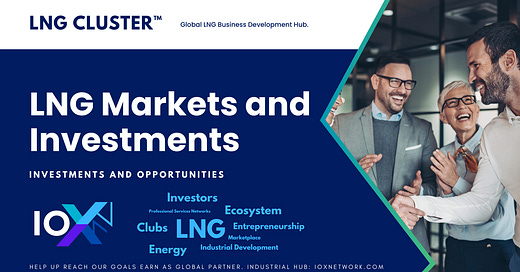LNG Pulse – Local Visions, Global Moves: LNG Evolves from Policy to Practice
New partnerships, indigenous empowerment, and evolving supply strategies are reshaping LNG’s role across regions.
From Canada to Congo: LNG Growth Goes Local and Global
The LNG landscape is no longer dominated solely by mega-projects and supermajors—it is increasingly shaped by localized strategies, regional resilience, and national policy decisions.
Canada's federal support for the Cedar LNG project, led by the Haisla Nation, marks a historic convergence between indigenous leadership and clean energy development. Funded in part by Canada’s Strategic Innovation Fund, Cedar LNG embodies the future: emissions-conscious, community-driven, and export-oriented. This is more than an infrastructure project—it’s a political and social blueprint for LNG’s next era.
Meanwhile, Japan's Tokyo Gas is turning westward, announcing plans to expand into the U.S. LNG market. Celebrating its 140th anniversary, the company is targeting mid- and downstream growth and LNG trading. This reflects an increasingly transactional and globally fluid LNG economy, where long-term offtakers evolve into active market participants.
At sea, the maritime sector continues to innovate. Havila Kystruten’s participation in an LNG-fueled shipping consortium—featuring onboard CO₂ capture and storage—signals a turning point in ESG-led vessel design. Pair this with Wärtsilä’s dual-fuel engine deployment for bunkering vessels, and it’s clear that LNG bunkering is no longer niche but foundational to low-carbon maritime logistics.
Conversely, signs of market adjustment are also evident. Osaka Gas has stated it sees no immediate need for additional U.S. LNG volumes, citing stable domestic demand. South Korea’s record nuclear output has reduced its LNG and coal imports to multi-year lows, offering a glimpse into what diversified energy systems might look like.
Add to this the continuing U.S. export activity—Venture Global’s Calcasieu Pass ready for full operation, and Delfin LNG signing long-term deals with Germany’s SEFE—and it’s clear: LNG is growing not just through volume, but through strategy.
Global Investments & Developments
Canada’s Cedar LNG Secures Strategic Federal Support Canada’s government has pledged funds through its Strategic Innovation Fund to support Cedar LNG—the first indigenous-led LNG export project in the country. This investment enhances reconciliation efforts while positioning Canada as a cleaner LNG exporter.
Tokyo Gas to Expand U.S. LNG Presence Japan’s Tokyo Gas is looking to deepen its footprint in the U.S. through LNG trading and downstream integration. This expansion illustrates a clear trend: Japanese utilities are no longer passive buyers—they’re becoming global LNG players.
Havila Kystruten’s CO₂ Capture LNG Ship Project Takes Shape In Norway, Havila Kystruten joins a consortium to develop LNG-fueled vessels with onboard CO₂ capture and storage systems, blending environmental responsibility with commercial operation.
Noatum Maritime Receives LNG-Powered Ro-Ro Vessel In Spain, Noatum Maritime has received its first LNG-powered vessel for its joint venture with United Global Ro-Ro, marking another milestone in European green shipping transformation.
Global LNG Trade & Markets
Germany’s SEFE Signs LNG Deal with Delfin Germany’s SEFE has signed an agreement to purchase 1.5 million tonnes/year of LNG from Delfin, underlining Europe’s commitment to long-term U.S. LNG supply amid geopolitical uncertainty.
Venture Global Calcasieu Pass Prepares Full Launch After years of spot cargoes, Venture Global’s Calcasieu Pass LNG plant is ready to fully commence long-term exports—adding significant new capacity to U.S. LNG output.
Vitol Expands with Congo LNG Deal Vitol has entered a farm-in agreement for LNG development in the Republic of Congo, adding diversity to global supply and reinforcing Africa’s role in LNG’s future.
European Gas Prices Dip on Stable LNG Inflows Despite ongoing geopolitical tensions, ample LNG deliveries are keeping European storage levels healthy and prices under control—evidence of the market-stabilizing power of LNG flows.
Investment Opportunities
South Korea’s Nuclear Gains Reduce LNG Demand—For Now South Korea’s surge in nuclear energy production has cut LNG and coal imports to multi-year lows. While short-term LNG demand may cool, long-term baseload demand remains due to industrial usage and seasonal heating.
Vietnam Proposes Tariff Cuts for LNG Imports Vietnam is proposing lower tariffs on LNG, among other goods, to boost competitiveness and attract more diversified supply. This may open new opportunities for U.S. and Qatari exporters.
Saudi Aramco Eyes New U.S. LNG Deal Sources say Aramco is nearing a major U.S. LNG agreement, possibly with Woodside’s Louisiana project. The entry of Aramco could add significant depth to U.S. LNG’s future financial backing.
Wärtsilä Dual-Fuel Engines Advance LNG Bunkering Tech With Wärtsilä’s dual-fuel engines powering Ibaizabal’s new LNG bunkering vessel, the LNG maritime segment is being revolutionized—offering long-term opportunities for OEMs and service providers.





